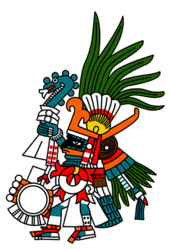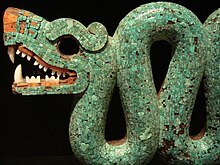Xiuhcoatl

Xiuhcoatl ( fire snake ) is a figure from the mythology of the Aztecs . It is represented as the weapon of the supreme god Huitzilopochtli . Xiuhcoatl is a Nahuatl word . Literally translated it means "turquoise snake", more freely it is translated as "fire snake". Xiuhcoatl was seen as the sun's lightning-like weapon and was seen as responsible for droughts and crop failures.
mythology
Xiuhcoatl was considered the nagual or spirit being of the Aztec fire god Xiuhtecuhtli , who was also seen as the patron saint of rulership. Like Xiuhcoatl, he, too, and with it the fire, was associated with the color turquoise and was perceived as ambivalent as destructive but also beneficial. Bernardino de Sahagún describes this connection:
The Lord of Turquoise ... and the holy flame, that's what fire is called, or the old God and our Father. He was seen as God because he burns people ... burns the fields and is charitable in many ways: you warm yourself with him, cook with him ... burn yourself a little dry with him, burn coals with him .
Exhibits and representations
statue
The British Museum has a stone figure representing Xiuhcoatl in its holdings. It features the head of a snake that has opened its mouth threateningly, and is provided with short legs with curved claws. The tail of the figure is shaped with two trapezoidal structures and a final triangle just like the traditional Mexican year symbol Xihuitl . The statue is originally 77 cm high and 60 cm wide. According to Guillermo Dupaix, a collector of Aztec antiques, the figure comes from Texcoco , a town on the east bank of the lake on which the pre-Columbian capital of the Aztec Empire, Tenochtitlan , was built. It had obviously been an ornamental representation that was integrated into a building. It was acquired by William Bullock in Mexico in 1823.
Illustration
In the Codex Borbonicus Huitzilopochtli is shown holding Xiuhcoatl raised in his right hand. Xiuhcoatl is typically turquoise.
mosaic
Also in the British Museum is a mosaic depicting a double-headed turquoise serpent. It is also interpreted as a representation of Xiuhcoatl.
Semi-automatic rifle FX-05 "Xiuhcoatl"
The Mexican semi-automatic rifle FX-05 Xiuhcoatl takes its name from the mythological Aztec fire snake. This is a recourse to the Aztec divine firearm of destruction.
Web links
Individual evidence
- ^ Eduard Seler: Some chapters from the historical work of Fray Bernardino de Sahagun , quoted from Günter Lanczkowski, page 41
- ↑ Archive link ( Memento of the original from January 19, 2009 in the Internet Archive ) Info: The archive link was inserted automatically and has not yet been checked. Please check the original and archive link according to the instructions and then remove this notice. Description of the stone figure Xiuhcoatl in the British Museum.
- ↑ http://www.bmimages.com/results.asp?txtkeys1=xiuhcoatl Turquoise mosaic of a double-headed snake (Xiuhcoatl) in the British Museum.


